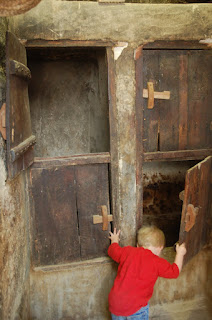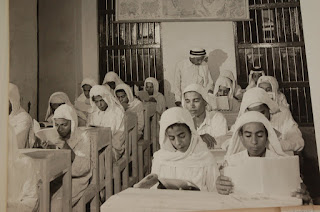Our next stop was a beautiful architectural piece of art built in the old Islamic fashion.
Amiriyah was the first school built in Al Hasa (again we would have driven right by had we been on our own as it's located in the commercial district).
 When our tour guide picked up this piece of wood and asked us what we thought it was for, of course I said for beatings and line writing. I was only half right...it was for writing on.
When our tour guide picked up this piece of wood and asked us what we thought it was for, of course I said for beatings and line writing. I was only half right...it was for writing on. The inner courtyard has been beautifully cared for and each school room displays different items such as: type writers, school books, ink wells, etc. I was surprised that they didn't care if you touched or picked up the items displayed. Of course, there were some things behind glass as well.
The inner courtyard has been beautifully cared for and each school room displays different items such as: type writers, school books, ink wells, etc. I was surprised that they didn't care if you touched or picked up the items displayed. Of course, there were some things behind glass as well. And again the ceilings were covered with palm leaf thatching and date palm trunks.
And again the ceilings were covered with palm leaf thatching and date palm trunks.

Not far from the school in the Kut district is the Mullah House. Now, not having grown up under a ruling King or Kings it has taken us some getting use to how much they pay homage to them here in the Middle East. In some countries, not in KSA, every other billboard shows their picture and graces us with their achievements. But they do throughout show immense respect when they speak of their Kings especially those who have passed. All I know is that when the last one here died everyone in Aramco got an extra bit of cash in their check.
This house is where King Abdul Aziz stayed for three days after he regained Al Ahsa in 1913. I have yet entered an off camp Saudi home and have often wondered what it's like behind those high walls. This visit at least gave us a taste of what it use to look like. This picture was taken from and inner courtyard surrounded by rooms on both floors.
 An interesting infant cradle was in the small woman's sitting room. Adjacent to this is the men's much larger sitting room.
An interesting infant cradle was in the small woman's sitting room. Adjacent to this is the men's much larger sitting room.
This kitchen was tiny! It did not seem adequate for a house this size.
Some of the traditional dishes from this area are:
Kabsa - Rice with meat, fish, chicken, or shrimp, onion, tomato, oil, cinnamon, cloves, black dried lemon, and other spices.
Mabzoul - Rice, tomatoes, yellow lentils, oil, salt, and spices
Qalba - Sheep meat, chickpeas, onion, tomato, and spices
Jareesh - Grounded grain, meat, tomatoes, butter, and sweet and hot spices.
Bread - Different types of bread are baked for different meals.
Lastly you would not be at a traditional Al Hasa meal if dates are not served and are often start the meal.

Ethan's favorite room was the weapon room as he pointed out all his favorites to me. Someone wise had previously attached these to the walls. By this time of the day the boys were used to picking up and handling what every they saw displayed.
 Colorful textiles are mainly used in woman's fashions. Men often just wear the traditional white or gray Thobe, seen in the middle, with the Gutra on their head. Darra'a are the colorful dresses and Bokhniq (shawl) are the long glittering head coverings. But of course if in public these would be covered with an Daffa (Abaya) and a Milfa' a black piece of cloth wrapped around the head. And of course we can't forget the black piece of cloth to veil (to add mystery:) that cover the face called Boshiyah.
Colorful textiles are mainly used in woman's fashions. Men often just wear the traditional white or gray Thobe, seen in the middle, with the Gutra on their head. Darra'a are the colorful dresses and Bokhniq (shawl) are the long glittering head coverings. But of course if in public these would be covered with an Daffa (Abaya) and a Milfa' a black piece of cloth wrapped around the head. And of course we can't forget the black piece of cloth to veil (to add mystery:) that cover the face called Boshiyah.



I love the pictures. Its great that you can discover the site that are right in your backyard.
ReplyDelete